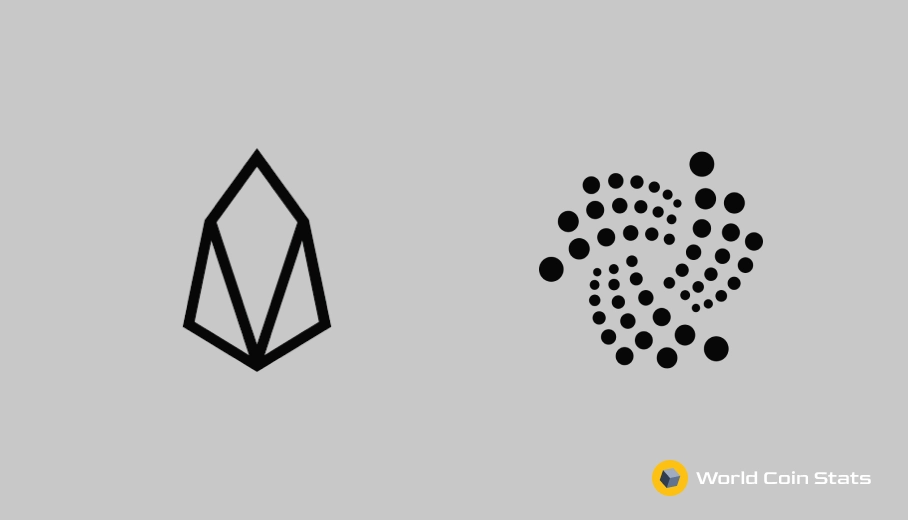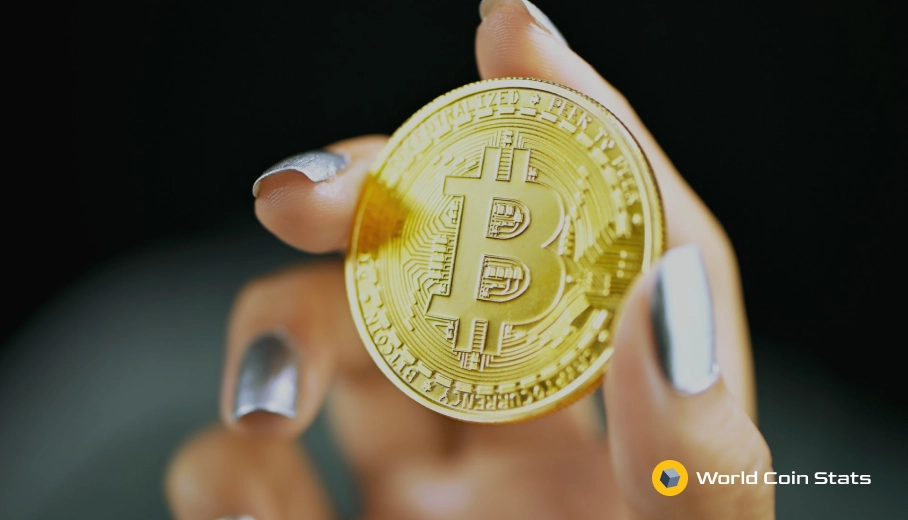EOS vs IOTA
EOS and IOTA are two of the bigger names in the cryptocurrency industry and are often compared. This is unusual to us because the two cryptocurrencies do not directly compete with each other. The comparisons mostly spring up because the two were launched at about the same time and operate in a similar altcoin space as each other.
With that in mind, this article will offer a comprehensive comparison of the two and explain which of the two is a better investment overall.
EOS vs IOTA – Basic Points
This section will offer a basic overview of the two cryptocurrencies. A full technical breakdown of the differences between the two projects is far beyond the scope of this article and as such will not be included.
EOS Basics
EOS is a fairly straightforward cryptocurrency to understand at its core. A good simple way to think about it is Ethereum without transactions and more centralization. Of course, it is a little more complicated than that, but we will only cover the basics.
Ethereum Competitor
First, EOS is seen as more of a direct competitor to Ethereum than IOTA. This is made pretty clear by EOS marketing itself specifically as an Ethereum competitor (read: Ethereum killer) during launch in 2017 and 2018.
With that in mind, EOS has a lot of the same functionality as Ethereum with smart contracts. Unfortunately for EOS, it does not have anywhere close to the decentralized finance market share as Ethereum.
No Transaction Fees
Ok, the biggest selling point of EOS is that it has no transaction fees.
That’s right, zero transaction fees.
This works because EOS uses a delegated proof of stake (DPoS) consensus model. In simple terms, this means that EOS holders vote on validators to verify transactions (hence the word delegated in PoS).
Those validators are paid by EOS minting new tokens rather than collecting transaction fees. In a way, everyone pays for transaction fees by increased inflation rather than simply paying a transaction fee.
Not Very Centralized
DPoS does increase speed. The downside is that it’s not particularly decentralized.
There are only 21 validators on the network.
The process for becoming a validator relies on EOS holders staking their tokens to cast a vote for the validators. This voting process does not end, so the validators can constantly update.
As you can imagine, this process can lead to whales controlling the blockchain quite easily. Most of the EOS validators (called BPs) are based in China. And rumors have circulated that Chinese cryptocurrency exchange Huobi is a BP, though that rumor was claimed to be false.
To summarize, EOS is centralized despite what founder Dan Larimer has claimed about EOS being less centralized than Bitcoin and Ethereum.
It’s a highly centralized cryptocurrency, which is a major drawback to any cryptocurrency project.
EOS Coin Information
Project Name: EOS.IO
Ticker: EOS
Price: $3.62
All Time High Price: $21.51 on April 29, 2018
Market Cap: $679 million
All Time High Market Cap: $17.7 billion on April 29, 2018
Total Supply: 1,031,575,097
Circulating Supply: 955,491,352
Max Supply: Infine
Inflationary? Yes
Consensus Model: Delegated Proof of Stake (DPoS)
Where to Buy EOS?
EOS is available on most major exchanges. Binance, Coinbase, Kraken, Huobi, Binance.US, and Bithumb all sell EOS.
Simply pick an exchange you like and purchase EOS – most exchanges should have EOS. As for storing it, the Trezor Model T and Ledger Nano both support EOS. There is also a native wallet, but we recommend a hardware wallet.
IOTA Basics
Again, we will not go super in depth with the technical details because, quite frankly, they are not particularly relevant to all but an extremely small subset of the population. This is especially true of something as complex as IOTA.
However, understanding the basics are still extremely important to understand the project.
Not a Blockchain
The first thing to understand with IOTA is that while it is a cryptocurrency, IOTA is not a blockchain.
Yes, IOTA is not technically a blockchain. Instead, IOTA relies on something called the Tangle, which is a different way to organize data than a sequential block.
Basically, the Tangle works by having one transaction verify two unverified transactions (called tips). This is much more efficient and scalable than blocks, which we will cover in a later section.
To summarize, a big difference with IOTA is that it is not a blockchain. It is actually something better than a blockchain.
No Fees + Decentralization
Next, IOTA does not have any fees. In our opinion, IOTA has found the best way to eliminate fees from cryptocurrency transactions.
Remember the Tangle we mentioned in the previous point?
Each transaction someone makes must first verify two transactions. This means that everyone that does a transaction serves as a miner, which eliminates fees.
Of course, a validation method like this also greatly increases the decentralization. There are no mining companies in Chinese warehouses that control the majority of the hash rate.
It’s a more fair system and one that will likely catch on in a few years time.
Internet of Things
So, the original purpose of IOTA was to be a sort of top protocol on the internet of things (IoT). It was not originally intended to even be used by humans. Here is an example of some use cases that IOTA has discussed:
You drive your smart car to a conference and pay for parking at the smart meter. The smart meter and smart car are both hooked into IOTA, so the smart car will automatically pay the parking fee using coins from your IOTA wallet.
Scalability
Finally, IOTA is much more scalable in theory than other cryptocurrencies. This is because of the way the Tangle operates. Bitcoin can process about 7 transactions per second, Ethereum can do ~15 transactions, and IOTA can do about 1000 transactions per second.
That does not tell the full story about IOTA.
Remember, IOTA transactions must confirm two pending transactions before processing the original one.
This means that IOTA actually speeds up as it gets more traffic (in theory). That is huge for scalability.
Decentralization, scalability, and security – IOTA appears capable of solving the trilemma.
IOTA Coin Information
Project Name: IOTA
Ticker: mIOTA (not commonly used)
Price: $0.7243
All Time High Price: $5.37 on December 19, 2017
Market Cap: $29.1 million (#47)
All Time High Market Cap: $14.9 billion on December 19, 2017
Total Supply: 2,779,530,283
Circulating Supply: 2,779,530,283
Max Supply: 2,779,530,283
Inflationary? No
Consensus Model: Proof of Work
Where To Buy IOTA (mIOTA)?
IOTA is not available on as many cryptocurrency exchanges as you would probably think. This is likely because the project is a little ‘out there’ compared to most cryptocurrency projects.
That said, you can find it on Binance, Binance.us, Bitfinex, and Huobi.
The most popular place to buy IOTA is the IOTA/USDT peg on Binance, which is the exchange we recommend if you want to purchase IOTA. Binance.us and Bitfinex are also good if you live in the United States.
EOS or IOTA as an Investment?
Both projects have garnered some attention as potential investments. However, only IOTA really stands out as being worth any consideration. IOTA does have some very clear risks to it that you should know about, but the potential for a massive payout is good enough that it’s worth considering.
EOS, on the other hand, has too many centralization concerns, a founder with a bad reputation, and an overall staleness to it. The price is still good. It just does not strike us as the best investment that one could make in cryptocurrency.
The Lowdown On IOTA
Admittedly, if you had to pick EOS or IOTA as an investment, then IOTA would be the superior choice. For one, it is not really a blockchain and was not even originally launched as a cryptocurrency – that was mostly used as a fundraiser during the ICO rush.
IOTA also targets a tech sector that is extremely likely to grow significantly over the next decade. That sector is the Internet of Things (IoT).
Furthermore, IOTA does have a next generation solution to the blockchain with the Tangle. The Tangle does appear to work well for organizing data and does appear to solve the blockchain trilemma.
We say “does appear” because this has not actually been tested in practice – it has only been tested in theory and dry runs.
So, what’s the problem with IOTA?
The biggest problem, in our opinion, is that the IOTA development team appears to have some internal conflicts, they have missed deadlines, and made promises that went unfulfilled. Though a lot of these problems were resolved with the firing of co-founder David Sønstebø in late 2020.
Basically, Sonstebo had a very polarizing personality that worked great for a startup. But that personality did not work out so great for running the company as it got larger and he was eventually forced out at the end of 2020.
To summarize, IOTA is a very speculative cryptocurrency.
Is the technology good?
Yes, we are not saying that the technology is bad. In fact, IOTA has a very real chance of becoming something truly groundbreaking if they can eventually launch smart contracts and compete directly with Ethereum.
However, at the moment, IOTA appears to be a few years ahead of the technology curve. This makes it a risky investment, but one that could pay off massively if the team plays their cards properly and continues developing the Tangle into something truly special.
The Problem With EOS
We know that EOS has seen some growth during the most recent bull market. However, this growth did not pace the growth of Bitcoin nor has it come anywhere close to the highs that EOS had in 2017.
That is not our problem with EOS, though. Our problem with EOS is that the ICO for it raised ~$4 billion USD.
Yes, $4 billion USD with a ‘b.’
Unfortunately, the project has not really lived up to the massive amount of money raised in the ICO. This might be mismanagement, but founder Dan Larimer also left his two previous projects Steemit and BitShares in shambles after raising a large amount of money.
It should not come as a surprise that Larimer left EOS as of December 2020.
Moving on from an apparent lack of leadership, EOS has more practical problems. The first being that Ethereum will offer a better scaling solution at some point in the near future with the full release of Ethereum 2.0. At that point, the so-called ‘Ethereum killers’ like EOS and Cardano will likely lose a significant amount of market share.
The final problem we have with EOS is the same one we have with Binance Smart Chain – EOS is not even decentralized. This was brought to light in 2017 when a Reddit post was made that showed an EOS ECAF moderator reversed a phishing transaction.
Of course, there is also the fact that only 11 block producers (BPs) are required to control over 51% of the network. And that makes collusion extremely easy for anyone that wants to reverse transactions, launch a 51% attack, or do any other censorship related tasks on the blockchain.
To summarize, EOS is not really decentralized, founder Dan Larimer has a reputation for dumping projects, and Ethereum appears that it has finally gotten its act together. EOS is not a very good long term investment.
Closing Thoughts
That sums it up for EOS vs. IOTA. The two cryptocurrencies are not really the best two to compare. IOTA has technology that could prove very promising in the future while EOS has major centralization concerns that will likely prevent it from achieving its stated goal of overtaking Ethereum.
That said, they are both large, popular cryptocurrencies that will likely be around for the long term future.




